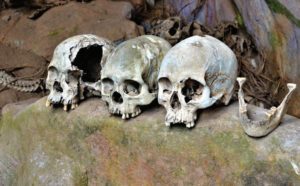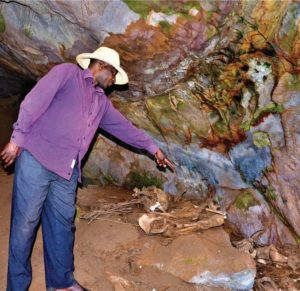Throughout man’s history all cultures have different ways in which they handle their departed and their final resting places (tombs). Those who leave this world to the next are considered to have been separated from us in body but remaining with us in spirit. In African traditional society it was considered that our departed forefathers lived among us and that our lives may be affected by the way we relate to them.
It is in this respect that, in the past the Abahinza, the rulers of the pre-aristocratic era in Rwanda were not buried with commoners in communal cemeteries but in selected caves on chosen islands. Lake Mutanda, lava dammed lake found in south western Uganda, Kisoro district is home to some of the Islands which were used for such a purpose.
According to tradition, there are many islands on Lake Mutanda, each used for a given purpose in the culture and religious customs and traditions that fore-fathers ordained them to be.
Descendant gives history
Louis Bishubeho, a local politician and tour guide in the area took us on a trip to one of the Islands where history lies. Bishubeho told us that he is a descendant of the Abahinza, and that he knows a lot about the history of this place.
“This was the burial ground of the Bahinza, my ancestors who were the rulers of the Great lakes region and Northern Rwanda. I do not feel ashamed to associate with the place because it holds my ancestors,” said Bishubeho.
Out of curiosity, we asked Bishubeho how he got hold of this history that can only be told by him in the current era. He told us that his late Grandfather shared all the details with him and then issued a number of directives prior to his death.
“My grandfather Bishubeho, who died at 128 years of age told me about this secret and asked me to share it with other members of our lineage. The aim of our discussion was to come up with strategies of how to pay respect to our ancestors resting in this place,” added Bishubeho. He further told us that despite the historical attachment they have to the area, there is a great spiritual connection they enjoy while visiting the site.
“We usually come here to pay respect to our ancestors and we believe that when we are here, we get blessings. You do not have to enter the cave, you only stand out and ask the ancestors to bless your plans and they are realized,” Bishubeho added.
At this place, we noticed that Bishubeho was barefooted and upon asking him why he visited this area in this form, he explained that since they consider the place sacred, it would be bad for him to step on his ancestors with shoes.
With the continued destruction around the site, Bishubeho called on the government to join efforts to preserve this place.
“Some of the remains that were here have been exhumed by the various people for their own selfish interests. Some tour operators exhumed these bones and displayed them here deceiving their clients that this was a punishment island yet we know the actual story behind these Islands. We are shocked to note that some of the remains here are taken away by witchdoctors,” he said.
Tourism department speaks out Richard Munezero, the Tourism Officer for Kisoro district said that his department has already taken note of the unique tourism product on this lake.
“We visited the site upon hearing the story of mummification and realized that it was true since we found some of the bones attached to the skins. As a district, we avowed that this could be a unique product and we have already started the process of gazetting it as a tourism site. We have already put up a sign post to direct tourists to the area,” said Munezero, adding that together with the Uganda Tourism Board and the Ministry of Tourism, they have already started the process of modifying the area and upgrading it to better standards.
“We are now in the process of getting archeologists who will document the actual story around this site with detailed professional information and analysis then we shall market this site with an improved approach,” he added.
Archeologist picks interest Ruth Tibesasa, a field archaeologist whose research interests are late Stone Age and early farming communities of Eastern Africa and PhD in Archaeology holder from the University of Pretoria has already picked interest in this site.

Tibesasa, a lecturer at Kabale University said that she has already developed a concept note that will see her profile the site in a professional manner.
“I will be working to determine the number of years some of these remains have spent on the site and the time when the people buried here could have lived. I will also be interested in bringing forward a strategy that will see communities sharing an informed story on the importance of conserving this site,” said Tibesasa.
She hopes to start her archeological journey in this place early next year.
About Mummification
A mummy is a person or animal whose body has been dried or otherwise preserved after death. When people think of a mummy, they often envision the early Hollywood-era versions of human forms wrapped in layers upon layers of bandages, arms outstretched as they slowly shuffle forward. Mummies may not literally rise from their ancient tombs and attack, but they’re quite real and have a fascinating history.
The practice of preserving a body as a mummy is widespread across the globe and throughout time. Many civilizations—Incan, Australian aboriginal, Aztec, African, ancient European and others—have practiced some type of mummification for thousands of years to honor and preserve the bodies of the dead.

Mummification rituals varied by culture, and it is thought that some cultures mummified all their citizens. Others reserved the rite of passage for the wealthy or people of status. Since most bacteria cannot thrive in extreme temperatures, exposing a corpse to the sun, fire or freezing temperatures was an uncomplicated way to create a mummy. Some mummies happened by accident. Take, for instance, the Accidental Mummies of Guanajuato, a collection of over 100 mummies found buried in above-ground crypts in Mexico. Those bodies were not mummified on purpose. It is thought either extreme heat or the area’s rich geological stores of sulfur and other minerals spurred the mummification process.
Some Buddhist monks practiced selfmummification by spending years starving their bodies and only eating foods that promoted decay. Once their body fat was gone, they spent a few more years drinking a poisonous sap to cause vomiting to get rid of bodily fluids. The poison also made the body an unsavory future host for corpse-eating bugs.
When the time was right, the monks were buried alive to await death and mummification. Death came quickly, but self-mummification seldom worked.
Egyptian Mummies
No matter how a body was mummified, the end game was the preservation of as much skin tissue as possible—and the priests of ancient Egypt are considered the experts on the process. Egypt’s arid climate made it easy to dry out and mummify a corpse, but the Egyptians routinely used a more elaborate process to ensure the dead experienced safe passage to the afterlife.
The mummification process for royalty and the wealthy often included: washing the body, removing all organs except the heart and placing them in jars and packing the body and organs in salt to remove moisture. Embalming the body with resins and essential oils such as myrrh, cassia, juniper oil and cedar oil was also part of the process. The process further included wrapping the embalmed corpse in several layers of linen.

